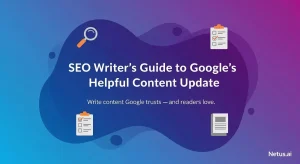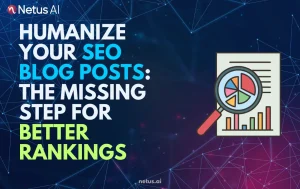
Why Google’s ‘Who, How, Why’ Framework Matters for EEAT | NetusAI
Why Google’s ‘Who, How, Why’ Framework Matters for EEAT AI can create articles in seconds. But here’s the truth: speed is not enough. Google wants
The Impact of Social Media on Plagiarism: Uncovering the Hidden Dangers

Content writer and editor for Netus.AI
The Impact of Social Media on Plagiarism. Social media platforms have become an essential aspect of daily life for millions around the world, informing, connecting, and entertaining users on a constant basis. As people continuously consume and share content online, the concern about plagiarism has become increasingly prevalent. A significant portion of information found on the internet may be plagiarized, and it raises the question of whether we should attribute this issue to the pervasive nature of social media or the advancement of technology itself. Undoubtedly, social media has amplified the prevalence of plagiarism, and in this article, we will discuss the reasons behind this concerning trend.
As we delve into the impact of social media on plagiarism, it is crucial to examine the factors that contribute to this ongoing issue. Understanding the relationship between the online world and the increasing levels of plagiarized content can help raise awareness and foster creativity. By exploring this topic, we aim to promote open and respectful communication within the online community, ultimately encouraging the cultivation of authenticity and integrity on social media platforms.
Plagiarism can be traced back to the 17th century, originating from the Latin word “plagium,” meaning theft. In essence, plagiarism involves presenting someone else’s work in the realm of art or science as one’s own or attributing it to another person. Throughout history, instances of plagiarism have been exposed, leading to disapproval from authors and society. Sadly, neither ethical considerations nor legal copyright safeguards can fully prevent it. The proliferation of social media and networks has further provided a conducive atmosphere for its growth.
The primary motivation behind plagiarism is often the pursuit of financial gain or public recognition. Consequently, a plagiarist is someone who unlawfully claims authorship in a conscious and deliberate manner, tantamount to theft. Such misappropriation of another’s property is a crime under the law and subject to strict penalties.
When writing, it is essential to provide proper attribution, especially when quoting, citing, or referencing sources. Utilizing citations ensures respect for intellectual property rights, adherence to ethical standards, and prevention of copyright infringement. Moreover, giving proper credit to the original authors protects the integrity of the writing process and contributes to the overall quality of the work produced.
To avoid plagiarism, writers should:
In today’s digital age, plagiarism has emerged as a significant issue in students’ writing assignments. The ubiquitous nature of internet content often makes it challenging to adhere to copyright regulations and identify the original creators. A comprehensive study by Dr. Donald McCabe and The International Center for Academic Integrity documented this problem between 2002 and 2015. Over 70,000 students from 24 schools across the United States participated in the study, and 95% admitted to cheating by claiming original authorship on their work.
Plagiarism can gravely impact students’ academic integrity, affect their credibility, and have severe consequences on their reputation and career prospects. Educational institutions must prioritize teaching proper citation practices and emphasizing the importance of original content in writing assignments. Penalties for plagiarism should serve as a deterrent while also promoting a deeper understanding of academic honesty within the college and university environments. Moreover, educators must address these issues proactively to maintain a high level of integrity in academia and safeguard students’ educational success.
Social media serves as a breeding ground for plagiarism. The ease of copying, reposting, and sharing content without proper attribution fuels the rapid spread of stolen material across various platforms such as Facebook, Twitter, and Tumblr. Below are key factors that contribute to the alarming increase in social media plagiarism.
1. Intentional Plagiarism
Much content found online, particularly on social media platforms, is designed to be copied or repurposed. Businesses aiming to promote their products and services often create marketing materials, press releases, and announcements that spread smoothly across the web. The wider their reach with minimum changes to the text, the greater their chances of success.
2. Lack of Control
Unlike academic institutions, social media lacks strict regulations surrounding content ownership. There are no governing bodies to enforce proper citation or impose punishments when plagiarism occurs. The worst-case scenario in terms of consequences is a lower search ranking from Google. Moreover, many users access social media sites using VPNs for their mobile devices, making it more challenging to track down plagiarists.
3. Casual Communication
The informal nature of social media communication further encourages plagiarism. Every day, millions of posts, videos, and images are shared, copied, and reposted without acknowledgment of their original creators. The rapid dissemination of content on platforms like Twitter and Facebook often makes it impossible to identify the initial source.
4. Lack of Credibility
As the online community expands, many individuals continuously post content without taking proper measures to protect its authenticity or give proper credit to the original author. This lack of citation perpetuates the cycle of plagiarism, as individuals unknowingly share and circulate others’ ideas without proper attribution.
To combat this issue, education on the ethics of plagiarism is crucial. Raising awareness of honest citation practices and the consequences of copyright infringement will help mitigate the growth of plagiarism on social media platforms. Additionally, providing users with easy-to-use tools for proper citation may simplify the process and promote a culture of giving credit where it is due.
When you come across intriguing content on the internet, you may want to share it with others. However, it’s crucial to do so without committing plagiarism and making sure the original author gets proper credit. Here are some guidelines to help you share content ethically and avoid plagiarism:
It’s worth noting that many people mistakenly believe the content on the internet is public domain and holds no copyright. This belief is false. Online content is protected by copyright law, just like works published in print. Authorship credit is essential for both mediums, as people invest time and effort into creating them.
With the growth of blogging, social media, and other communication platforms, everyone bears responsibility for creating and sharing authentic, unique content. Fortunately, numerous technologies and accountability measures, such as plagiarism checker tools, are available to help with detection and prevention of plagiarism. By adhering to these guidelines, you can contribute to a culture of originality, respect, and lawful content sharing.
Social media platforms make it incredibly easy to share content, which can lead to the rapid spread of plagiarized materials. The ease of reposting, retweeting, and sharing can facilitate the dissemination of content without proper attribution or regard for copyright law. Often, users are unaware that they are sharing plagiarized work, contributing to the problem unknowingly.
Academic plagiarism becomes more prevalent as a result of social media’s influence. Students may share or repost content on their social media accounts, mistakenly believing that doing so does not constitute plagiarism. This can lead to confusion about what counts as academic dishonesty and may result in plagiarism in their assignments and research papers.
The ease of sharing on social media platforms, such as copy-pasting or retweeting, results in content being disseminated quickly and widely. This can make it difficult to trace the original source of the content, and users might not check for proper attribution before sharing. This practice perpetuates the spread of plagiarized content and diminishes the importance of giving credit to the original author.
Content shared on social media must adhere to copyright laws, just like any other published content. Users who share copyrighted material without permission or proper attribution could potentially face legal consequences. Social media platforms also have their own policies to protect copyright holders and may remove infringing content.
To detect and discourage plagiarism from social media sources, educators can use a variety of strategies, such as:
Social media can contribute to a more relaxed attitude toward plagiarism due to the prevalence of sharing and reposting content without attribution. Students might not understand the difference between sharing on social media and properly citing sources in an academic context. It’s important for educators to address these misconceptions and set clear expectations about plagiarism and academic integrity.

Why Google’s ‘Who, How, Why’ Framework Matters for EEAT AI can create articles in seconds. But here’s the truth: speed is not enough. Google wants

SEO Writer’s Guide to Google’s Helpful Content Update Keeping up with Google’s algorithm changes can feel like a relentless game of whack-a-mole. Just when you

Can AI Content Be Safe for SEO in 2025? Let’s start with the question of keeping every content strategist, SEO pro and blogger awake at

Humanize Your SEO Blog Posts: The Missing Step for Better Rankings You’ve done everything by the book. Your keyword research is impeccable. Your meta descriptions

How to Pass AI Detection Tests as an SEO Writer Let’s paint a familiar picture. You’ve just finished a blog post. The headline is sharp,

Why Your AI SEO Blog Isn’t Ranking (And How to Fix It) You embraced AI for your blog. The promise was intoxicating: high-quality content, published
@ 2024 Netus AI.